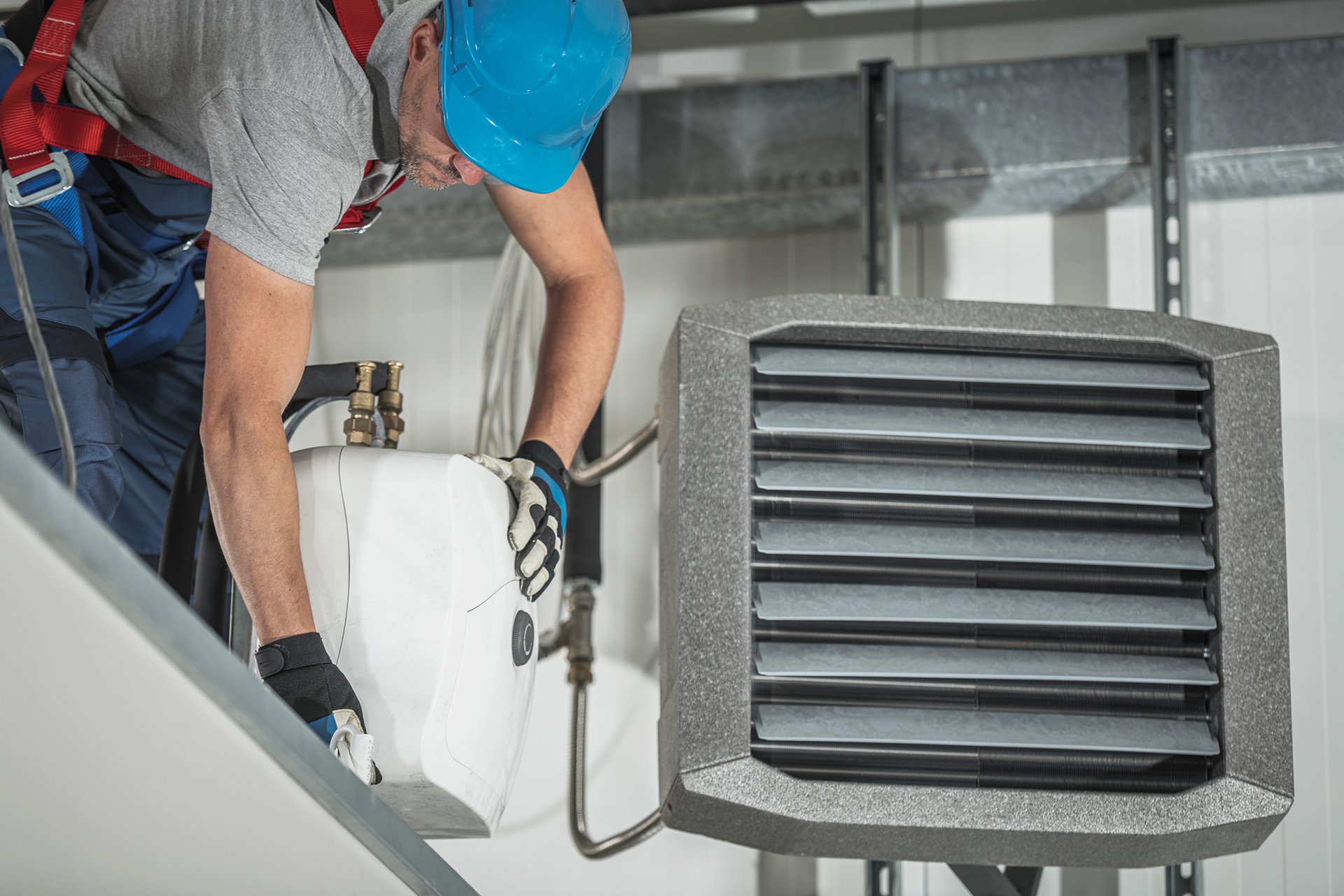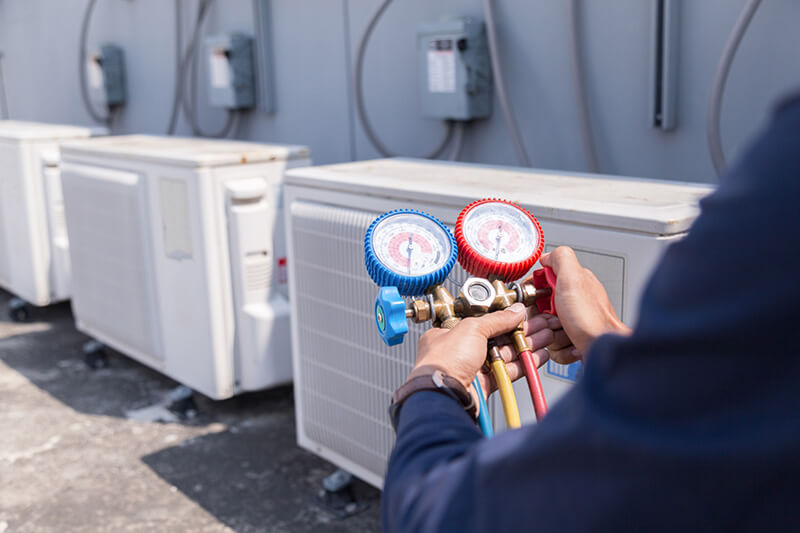Just How a Heatpump and Furnace Collaborate to Optimize Your Home's Home heating Effectiveness
Understanding just how a heatpump and furnace collaborate is crucial for house owners seeking reliable home heating options. Each system has its toughness, supplying a well balanced approach to home convenience. The heatpump stands out in modest temperatures, while the heater supplies quick warmth throughout severe cold. This synergy not just reduces power costs however also improves the lifespan of both home appliances. What factors affect this collaboration, and just how can property owners optimize their benefits?
Comprehending Warmth Pumps: Exactly How They Function
Although lots of people may be not familiar with their internal workings, warmth pumps play a necessary role in modern-day heater. These gadgets operate by moving heat from one place to an additional, utilizing the principles of thermodynamics. In chillier months, a warmth pump removes heat from the outside air, ground, or water, and transfers it inside your home to warm up the home. Alternatively, during warmer months, it can reverse the procedure, functioning as an a/c unit by getting rid of heat from inside to the outside.Heat pumps include an evaporator, condenser, compressor, and growth valve. The refrigerant within the system soaks up warm as it evaporates at low temperatures and pressures. The compressor then enhances the pressure and temperature of the refrigerant, allowing it to release heat as it condenses. This efficient process can significantly minimize energy consumption compared to traditional heating approaches, making warmth pumps a lasting selection for environment control in homes.
The Function of Furnaces in Home Heating
Heaters play an important role in home heating by offering a reputable source of warmth throughout the cooler months. They run by producing heat through burning or electrical resistance, distributing it throughout the home via air ducts or glowing systems. The performance of a heater is usually gauged by its Yearly Gas Use Performance (AFUE) score, which suggests exactly how successfully the device transforms gas into heat.Furnaces can use different power resources, consisting of all-natural gas, electrical power, gas, or oil, enabling homeowners to pick the most ideal option for their demands. Unlike heatpump, which might have a hard time in severe cold, heating systems maintain constant efficiency, guaranteeing that interior temperatures continue to be comfortable no matter of outside conditions. Furthermore, modern heating systems typically come equipped with sophisticated modern technology, such as variable-speed blowers and wise thermostats, enhancing their effectiveness and responsiveness. This convenience makes furnaces a crucial component in all-inclusive home heating approaches.

Benefits of Making Use Of Both Equipments With Each Other
Incorporating the toughness of both furnaces and heatpump can lead to a more efficient and effective home heating remedy. Using both systems enables homeowners to benefit from the heatpump's energy efficiency during milder temperature levels while counting on the heating system for more extreme cold conditions. This dual approach can greatly reduce power expenses, as warm pumps eat much less electricity than standard home heating techniques when temperatures are moderate.Additionally, using both systems with each other can boost comfort levels in the home. Heatpump can provide consistent, also home heating, while furnaces can quickly increase ambient temperature levels when required. The combination of both systems can extend the life-span of equipment by lowering wear and tear on each device, as they share the work. Eventually, property owners can appreciate a well balanced, cost-efficient home heating solution that readjusts flawlessly to differing weather, ensuring a cozy and inviting home throughout the winter season months.
How Heat Pumps and Furnaces Enhance Each Other
When house owners integrate heatpump and heaters, they create a corresponding home heating system that makes best use of efficiency and convenience. Heatpump run by moving warmth from the outside air or ground, making them highly reliable in modest climates. They succeed throughout milder temperature levels, offering affordable home heating. Conversely, heaters create heat via combustion or electric resistance, supplying solid, prompt warmth throughout extreme chilly conditions.The combination of these two systems allows for vibrant modifications based upon temperature fluctuations. During warmer months or milder wintertime days, the heatpump can take the lead, saving power and decreasing expenses. As temperature levels drop, the heater can flawlessly involve, making certain regular warmth throughout the home. This harmony not only enhances power usage but also improves the life expectancy of both systems, as each system operates within its perfect efficiency range. Together, they develop a well balanced setting that adapts to differing environment needs.
Maximizing Performance: Tips for Homeowners
House owners can improve their heating efficiency via numerous practical approaches. Establishing a routine upkeep timetable, incorporating wise thermostat technology, and carrying out reliable insulation and securing solutions are crucial actions. These procedures not just top article enhance comfort yet also reduce energy expenses.
Normal Maintenance Schedule
To guarantee optimal heating effectiveness, establishing a normal maintenance schedule is important for any kind of home. House owners need to focus on regular evaluations of both heat pumps and heating systems to ascertain peak performance. This consists of altering air filters each to 3 months, as clogged filters can greatly reduce performance. Additionally, organizing expert upkeep a minimum of annually enables service technicians to determine and resolve potential concerns prior to they escalate. Homeowners should also clean the heatpump's outdoor system to protect against debris build-up that can hinder air flow. By sticking to a regular upkeep schedule, house owners not just improve their heater' effectiveness yet additionally prolong their life-span, bring about higher convenience and lowered power costs throughout the chillier months.
Smart Thermostat Integration
Incorporating a smart thermostat right into a home heater can significantly improve energy performance, particularly as it enables for exact control over temperature level settings. These devices can find out the property owner's schedule and choices, automatically readjusting the temperature level to enhance comfort while lessening power usage. They can lower home heating throughout times when the home is vacant, decreasing unneeded consumption. Lots of wise thermostats likewise offer real-time power use information, enabling property owners to make informed choices about their home heating habits. Additionally, remote accessibility by means of smart device apps enables customers to adjust settings from anywhere, guaranteeing the home is cozy upon return. In general, wise thermostat assimilation not just improves comfort but substantially adds to power savings and performance.
Insulation and Sealing Solutions
Smart thermostats play a vital duty in energy efficiency, but their efficiency can be considerably improved by appropriate insulation and securing remedies. Homeowners ought to prioritize protecting walls, floors, and attic rooms to lessen warmth loss. High-quality insulation products, such as spray foam or fiberglass, can substantially boost thermal resistance. Furthermore, sealing gaps around windows, ducts, and doors protects against chilly air infiltration and warmth getaway. Weatherstripping and caulking are efficient methods for addressing these leakages - heat pump service. Regular inspections for air leaks, together with using blower door examinations, can help identify problem locations. By purchasing insulation and securing, property owners can maximize the efficiency of their heater, inevitably bring about decreased energy consumption and reduced utility bills
Common Misconceptions Concerning Warm Pumps and Furnaces
What false impressions border heatpump and heating systems? Numerous individuals erroneously think that heatpump are inefficient in chillier climates. Actually, modern-day heat pumps are designed to run successfully see this even in low temperatures, supplying trustworthy heating throughout wintertime. Another common myth is that heating systems are always much more reliable than warm pumps. This depends on the particular power sources and performance scores of the devices in question. Some might also assume that utilizing both systems simultaneously is unnecessary, but actually, this combination can enhance home heating effectiveness, specifically during extreme climate condition. In addition, individuals commonly assume that heatpump require continuous upkeep, when actually, they have similar maintenance needs to typical heater. By disproving these misconceptions, house owners can make more educated decisions concerning their home heating Full Report options, inevitably causing enhanced convenience and power efficiency in their homes.
Maintenance Considerations for Combined Solutions

Frequently Asked Questions
Can Warm Pumps Job Effectively in Very Cold Climates?
Heat pumps can have a hard time in very cold environments due to minimized performance and warmth extraction limitations. However, innovations in technology have led to versions created for far better performance in such problems, boosting their viability in severe environments.
Just How Lengthy Do Warmth Pumps and Furnaces Generally Last?
Heatpump commonly last 15 to two decades, while heaters have a life expectancy of 15 to three decades. Routine maintenance can extend their longevity, ensuring efficient procedure and minimizing the requirement for premature replacements.

What Is the Average Expense of Putting Up Both Systems?
The average expense of mounting both a heatpump and a heating system commonly ranges between $5,000 to $10,000 - heat pump service. Variables influencing this expense consist of system size, installment complexity, and regional labor prices
Exist Tax Obligation Rewards for Making Use Of Energy-Efficient Heating Systems?
Lots of homeowners inquire about tax obligation motivations for energy-efficient furnace. Numerous government and state programs often supply debts or rebates, urging the adoption of sustainable technologies to decrease power intake and advertise ecological duty.
Exactly how Do I Pick the Right Dimension Heatpump and Furnace?
Choosing the appropriate size heat pump and furnace includes determining the home's square video, thinking about insulation quality, and examining regional environment. Consulting a specialist can assure suitable system efficiency and power performance based upon certain requirements. heat pump service. Comprehending exactly how a warm pump and heating system work with each other is essential for homeowners looking for effective heating solutions. In colder months, a warmth pump essences heat from the outdoors air, ground, or water, and transfers it indoors to warm up the living area. When homeowners incorporate warm pumps and heaters, they develop a complementary home heating system that makes best use of effectiveness and convenience. Warm pumps operate by transferring heat from the outdoors air or ground, making them extremely efficient in modest environments. Warm pumps can battle in incredibly cold environments due to minimized performance and warmth removal restrictions